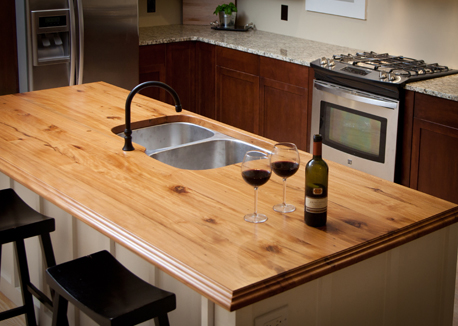If your client is looking for a something to distinguish their kitchen from others in the neighborhood, incorporating wood countertops may be an effective solution. For those building from scratch, integrating wood is easy enough. With little trouble, it can be used on an island, especially one that is to serve as a great focal point, as well as for perimeter countertops, coffee bars, built-in desk areas and wine bars.
TAKE A SECTIONAL APPROACH
For those who are remodeling an existing kitchen, following are some tips to help you integrate wood for optimum effect:
• Start at the island. If granite or some other stone is used throughout the kitchen, you may want to consider replacing just the island countertop with a wood surface to create contrast. This in turn will place the focal point of the kitchen on the island.
• Try the stove. Alternatively, if there is no island or if the perimeter counters need sprucing up, you can replace a portion of the perimeter countertop with wood, such as either side of the stove. Your clients may initially shy away from this idea, thinking they won’t be able to set hot pots on the counters nearest the stove. But there is no reason to worry. Stainless-steel heat rods can be embedded into the top to give them a functional, permanent trivet.
The homeowner should understand your goal is to make their kitchen functional. Wood is a durable surface. In addition, your clients shouldn’t be afraid to put appliances into their wood countertop. Just as with granite, stoves and sinks are completely safe.
 A small sink is integrated into the corner of this beech wood countertop that has been customized with drain panels. Photo courtesy of Craft-Art, Inc.
A small sink is integrated into the corner of this beech wood countertop that has been customized with drain panels. Photo courtesy of Craft-Art, Inc.• Add to a desk or eat-in bar. Another creative option is to integrate a wood countertop or butcher block into a raised or lower desk or eat-in bar area. By integrating wood into a granite surface, you break up long lengths of stone and add not just warmth and texture, but a custom feel that won’t look like every other kitchen on the block.
CUSTOMIZE TO THE HOMEOWNER’S LIFESTYLE
A kitchen that is truly a custom creation is one that reflects the homeowner’s lifestyle and personality. If you’re incorporating wood countertops, consider where and how they would best complement your clients’ functional needs.
• For cooks. For instance, a homeowner who loves to cook would benefit from adding a butcher-block portion to the countertop that has been finished with a food-safe penetrating oil. It can be used to prepare food and chop vegetables.
• For wine lovers. Wine enthusiasts may want to replace the granite by their wet bar with wood that uses a penetrating crosslinked tung oil finish. This tough, durable finish will repel wine spills and gives the area a look you’ll find at an upscale winery or a high-end wine cellar.
• For coffee lovers. Similarly, for coffee lovers—whether they have their own cappuccino machine or a single-serve coffee maker—a wood countertop can be used to articulate their own coffee bar and make it stand out.
EXPERIMENT
Once the location of the wood countertop is decided, it’s time to choose the wood species—and there are a lot of choices.
Domestic species abound, ranging from cherry, maple, hickory to black walnut. In addition, woods come in a variety of exotic species, including zebrawood, wenge and teak, all of which will add color, texture and warmth to a kitchen. Can’t decide on just one wood? Consider a checkerboard wood countertop that combines two different species for a unique punch of color.
Like a rustic appearance? Specify a distressed wood top, a process done by hand that adds age and patina to the wood from the get-go. There are also green wood options, like bamboo and lyptus, or reclaimed wood that has been repurposed as a countertop from an old barn, warehouse or home that has been torn down.
Avoid matching your clients’ wood countertops to their wood cabinets, hardwood floor or even an existing granite countertop. Pick a color that will accent the kitchen and coordinate with the other colors. You may also want to keep your use of woods to the same color family by sticking, for example, with browns, red tones, gray-green tones or light woods, such as heart pine or maple.
Here’s an example. In a kitchen with antique heart pine floors that are a pale gold color, you may want to choose cabinets that are stained a dark mahogany and a reclaimed beech wood countertop with an overall golden background and fairly dark knots. This will allow the floor, counter and cabinets blend together nicely.
 A granite countertop and dark stained cabinets work in harmony with the focal point of the kitchen—a painted island cabinet with a reclaimed beech wood island top. The dark patterns in the beech island top tie in with the dark stain of the cabinets where surfaces and woods need not match, but complement or accent one another. Photo courtesy of Craft-Art, Inc.
A granite countertop and dark stained cabinets work in harmony with the focal point of the kitchen—a painted island cabinet with a reclaimed beech wood island top. The dark patterns in the beech island top tie in with the dark stain of the cabinets where surfaces and woods need not match, but complement or accent one another. Photo courtesy of Craft-Art, Inc.As with design in general, incorporating wood into a kitchen requires striking a fine balance in color and finish. But when done well, the effect can be stunning and anything but cookie-cutter.
—Christine Gobble is the program coordinator in charge of residential sales
Craft-Art, Inc.









